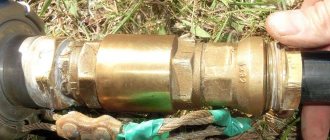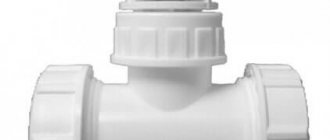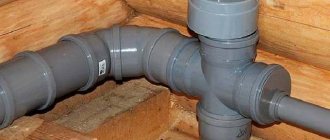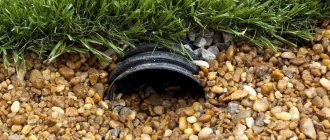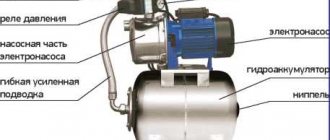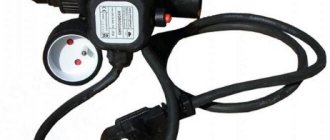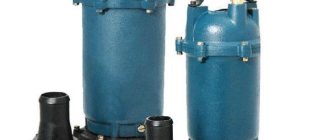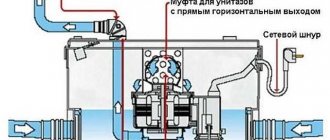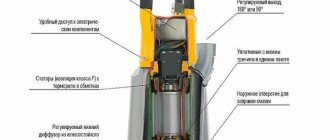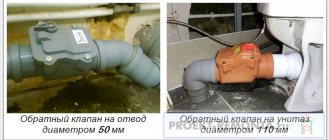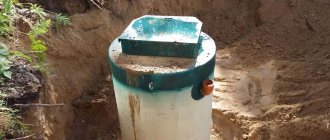A sewer check valve is a device that prevents flooding of an apartment as a result of sewer blockages or other malfunctions.
Before purchasing a 110 or 50 mm sewer check valve, it is important to understand the features of different types of locking mechanisms and their operating principles. It is also recommended to find out all the information about the existing sewer system.
Installation is quite simple; additional equipment is usually not required. It is important to purchase the device from trusted sales outlets, and also make sure that there is a warranty from the manufacturer.
Why is the device needed?
A sewer check valve is a device that is designed specifically to prevent leaks and backflow of water due to clogged sewer lines. Sometimes even a package that accidentally gets into the pipeline leads to blockages and flooding of the apartment.
To protect the room from the reverse movement of sewer system waste, a special valve is installed that operates automatically. A similar mechanism is used not only in offices, cottages, residential buildings and industrial premises, but also in heating and water supply systems (for the pump).
Their operating principle is quite simple: if the waste liquid begins to move in the opposite direction, the locking mechanism stops this movement, as a result of which flooding does not occur.
In most cases, the need to install the device arises in the following situations:
- regular entry of debris and large objects into the sewer system, as well as other violations of operating rules;
- a long period of use of the pipeline, during which a layer of grease with dirt particles has formed on the inner surface. This significantly increases the likelihood of clogging;
- the slope of the sewer pipeline is too large or small, because to ensure free gravity flow of liquid, it is important that a certain speed of movement of the wastewater be maintained;
- bends located at a perpendicular angle to the sewer pipe. As a result, the speed of water movement changes sharply and a water blockage may occur.
If in a multi-storey building with a single riser, residents of first-floor apartments installed a check valve for the sewer system at 50 or 110 millimeters, then flooding with drainage can occur even on the 2nd floor. The liquid will not get further up, because... pressure will most likely cause the blockage to clear.
In country houses, similar locking mechanisms are also often installed. However, then it is recommended to install them on the street, after collecting all the branches of the sewer pipes into a single one.
Purpose of sewer valves
The main purpose of such devices is to create an obstacle to the movement of liquid and unpleasant odors in the opposite direction. In this case, it is necessary that there is a free passage of wastewater from the toilet into the cesspool or septic tank. Valves for sewerage are conventionally divided into 2 types, and they perform completely different tasks:
- A non-return valve prevents waste from entering the bathroom in a multi-storey building. If the sewerage system is connected to a collector or septic tank, then, accordingly, liquid from there should not flow into the house part.
- The ventilation valve is designed to stabilize the external, atmospheric pressure and air flow in the sewer pipes passing inside the house. This air rarefaction can appear in different sections of the pipes as the temperature drops. Sometimes explosive sounds and vibrations of air masses are heard in the sewer system, leading to the destruction of hydraulic valves.
Types of valves and principle of operation
There are several types of sewer check valves of 110 and 50 millimeters, which differ in their scope of application. Accordingly, all types of mechanisms have a different design and operating principle of one element.
In general, all varieties have a single mechanism of operation of the system: in a quiet state, the blocking valve is located at the bottom, thus closing the lumen of the pipeline and preventing the reverse flow of liquid.
When the waste liquid approaches, the damper automatically rises, after which it returns to its original position. It is by the mechanism of operation of the damper that models of sewer check valves are classified.
Rotary
This type of sewer valve has a spring-loaded membrane (it is called a plate because of its round shape). When the wastewater moves in the right direction, the plate rotates and moves upward without impeding the movement of liquids.
However, when the drains are directed in the opposite direction, the spring-loaded membrane is pressed tightly against the outer rim, as a result of which the working area of the pipeline is blocked.
Some models additionally have a built-in additional damper, which is controlled manually. This locking mechanism can be adjusted using a special button located on the body of the device.
Due to the peculiarities of the design shape, this type of check valve for sewerage 50/110 mm is also called petal. As a rule, the device body is larger in size than the dimensions of the pipe where it is mounted.
Thus, the pipeline first has an expanding and then a narrowing section, which is a possible place for the formation of a blockage in the sewer system. The solution to this problem is to place the lid mechanism at the top of the housing. By removing it, you can easily and quickly remove the clog that appears.
Lift valve for sewerage
The name of this type of device is based on the mechanism of the damper.
When wastewater moves in the correct direction, the flapper is positioned at the top. Operating principle: the liquid exerts pressure on the membrane, which blocks the movement of waste, the internal spring is compressed, as a result of which the damper rises. If the wastewater does not move, then the spring is in its normal state, and the path of the wastewater is blocked.
Due to the nonlinear body shape, when the fluid moves in the opposite direction, opening the valve is impossible, which ensures complete safety from flooding.
This type of check valve for sewage 110 or 50 mm has greater operational reliability than the rotary (petal) model, but there is also a drawback.
The shape features make it necessary to regularly clean the system, because... it gets clogged periodically. To perform this procedure, you will need to unscrew the bolts (4 pcs.), then thoroughly clean or, if such a need arises, replace the working mechanism. If the owner has the opportunity to carry out regular cleaning, then it is better to purchase a similar version of the check valve.
Ball valve
In this type of device, the locking element is a small ball. The upper part of the body is designed in such a way that when wastewater flows, the ball falls into a separate hole and allows the flow to move.
When there is no fluid present, the working area of the pipe is blocked, preventing flow from flowing in the wrong direction. However, such models have a drawback - unlike the rotating and lifting mechanism, in this design the ball valve does not completely adhere to the rim of the device.
As a result of a leak, a small amount of waste water may leak. Of course, the likelihood of severe flooding, as if the sewer check valve were missing entirely, is minimal.
Wafer
The main advantage of this type of locking mechanism is its small dimensions, which makes installation possible even if there is no free space behind the plumbing fixtures. Externally, the device looks like a miniature cylinder with a special rotary valve.
This element can consist of 2 components that are fixed to the central rod, or in appearance it can resemble a small plate that is fixed to the body using a spring mechanism.
It is advisable to install this option only if other varieties cannot be installed. Even taking into account the small size, it is still advisable to give preference to other types of devices. A 50 mm wafer check valve for sewerage is installed quite rarely, because... belongs to the category of water supply equipment. For sewer systems, its efficiency is quite low.
Another disadvantage of this design is the inability to quickly clean the device. Due to its shape, the connection will need to be completely disassembled to clean the valve.
Correct and incorrect placement
Each device, open or closed, has the direction of movement of the drains drawn on the body. Indicated by an arrow or triangle. It is in the direction of the water that the water seal is installed.
The shutter only works in one direction and in different positions: whether the device is vertical or horizontal. If all installation conditions are met, in the first minutes it will be clear that the device is functioning and water is passing through the membrane.
The correct position of the device is also determined by the installation method. From the socket to the empty end (that is, into the socket), only the empty end of the pipeline can be inserted. On the other side there is only a connecting extension of the pipe with a rubber seal.
Incorrect placement can lead to permanent problems with the device. A device installed incorrectly or in the wrong place will immediately show its failure. Any work begins with reading the instructions, installation of the codpiece is no exception.
Difficulties that may arise if installed incorrectly:
- Hard to reach place. The device requires constant monitoring after installation, therefore, if the shut-off valves are located in a corner or under a layer of concrete in another inaccessible place, it is not possible to maintain it.
- The device was installed in violation of the technological process. Leaky joints, constantly leaking lids - seals are an unpleasant sight. If the rubber bands in the socket are not lubricated with oil during installation, they will ride up or fall inward. Even when all the joints are attached to each other tightly and tightly, they can leak due to the rotation of the O-rings.
- The throttle cannot be installed immediately after the rotating part of the system. During movement, the drains gain decent speed, which means they create pressure. The pipe became clogged or could not cope with the backflow, and the valve closed. The problem was not immediately detected and water continued to flow from the plumbing fixture. The flow of water approaching the membrane will receive resistance and can knock the outlet out of the connecting joint. Therefore, the device is installed strictly on a straight section.
- The valve installation direction is incorrect. Any device has a water movement indicator; installation must be carried out according to this figure. If the device is turned over or placed with the lid down for inspection, the unit will stop working.
How to install the valve
Instructions for installing a check valve for 110 mm sewerage:
- Find a suitable place to install the device, it is important to take into account the diameter of the pipeline. Products of 110, 100, 50 and 40 mm can be used, depending on the cross-section of the pipe.
- Before installation, it is important to manually check the tightness of the structure. If you suspect problems, it is recommended to contact a store or service center and replace the device under warranty.
- Carefully cut the pipeline and install the valve. When performing the procedure, it is important to take into account the direction of movement of wastewater; it must coincide with the arrow shown on the plastic body of the product.
- Sealants made of silicone or rubber are certainly installed at the ends of the cut pipe. In most cases, the second option is used.
- The functionality of the sewer valve is checked. If the installation was carried out incorrectly, wastewater will rise up.
When performing the procedure, it is important to adhere to certain recommendations in order to install a check valve for 50/110 mm sewerage. These include:
- You should definitely make sure that the arrow on the body is directed exactly in the direction of normal fluid movement;
- installation when using a plastic model is quite simple: the edges of the pipeline are connected to the valve socket. The formed connection, as a rule, is already sealed, but you can additionally coat it with special silicone sealants intended for plumbing fixtures;
- When installing a cast iron device, a sealing rubber band and bolts are used that tighten the mounting plates. Some models on the market have sockets, their installation is no different from the installation of plastic varieties;
- When choosing a suitable location, it is important to consider the possibility of unobstructed access to the removable cover. This will be required if the locking mechanism becomes clogged and there is a need to clean it.
Why is a 110mm air check valve used?
To eliminate the possibility of wastewater entering the room, an air valve is mounted on the drain pipe, which allows air into the system and prevents it from coming out back. Such a shut-off element also helps to reduce the noise level in the system when the waste stream moves.
When water is drained, a vacuum occurs in the sewer system, causing air to enter it. This is accomplished due to the presence of ventilation or plumbing fixtures that have the smallest water seal. As a result of the vacuum, the membrane opens, and after the pressure stabilizes, it closes, which prevents the flow of air back into the room.
The air check valve for sewerage is made of high quality plastic. The element consists of a body, a membrane or rod, a rubber seal and a cover. The membrane reacts to excess pressure in the network and is activated when it occurs. The operating mode of the rod is controlled by the sealing gasket. The element is connected to the pipeline through a side hole.
Fan valve 110 mm is fixed only in a vertical position
A 110 mm vent valve for sewerage, like a return valve, is installed no higher than the 2nd floor. It should be located above the largest sewer pipe connected to the device. The valve is fixed in a vertical position. It is mounted to the pipeline using a socket connection, complete sealing of which is ensured using rubber cuffs treated with silicone.
Important! The air valve is installed in a place where the temperature will not drop below 0 °C.
The locking element can be automatic, anti-vacuum or a combination. The first type of product has a low throughput. The second valve option works well at low pressure. The combined version combines the features of both types of devices.
Product materials and sizes
When choosing a sewer check valve model, it is recommended to know what materials the device is made of, as well as the dimensions of the products. The most common materials:
- stainless steel;
- cast iron alloy;
- bronze;
- plastic.
In most cases, a check valve is purchased from the same material as the pipeline installed in an apartment or private building. It is not recommended, for example, to buy a plastic device for cast iron pipes. The most popular choice in terms of price/quality ratio is a valve made of high-quality plastic.
The dimensions of the device depend on the amount of free space. There is also such a characteristic as the connection method - horizontal or vertical. In most cases, devices for horizontal connections are used, but if there is not enough free space behind the toilet, bathtub and other plumbing fixtures, then vertical check valves are installed. If there is critically little space, then it is recommended to purchase a wafer type of mechanism. For its installation, only seals are required.
Tips for choosing
You need to buy a device that has:
- reliable design, made of durable materials that are resistant to aggressive environments and easy to maintain (have an easily removable cover for cleaning body parts);
- automatic shut-off mechanism for reverse flow of wastewater;
- manual adjustment in case of emergency.
In addition, the diameter of the valve bells must correspond to the diameter of the pipeline section where it will be installed.
Is it really necessary?
Installation of a sewer check valve 50 or 110 is not always required; there are certain situations when installing this device does not make much sense. For example, residents of apartments on the 6th floor of an apartment building do not have to worry about possible sewer flooding through the central blockage, because... the pressure of waste fluids will not maintain a high level when rising to the 6th floor.
In general, there are situations when it is strongly recommended to install the device:
- location of the apartment on the first/second floor of a multi-storey building;
- location of office space on the first two floors;
- private 1-storey house;
- cottage-type country house with 2-3 floors.
In the above situations, it is financially more profitable and easier to install a valve on plumbing fixtures in advance than to later repair the premises and deal with the negative consequences of a clogged and broken sewer. It is especially important to install the mechanism in houses with old pipelines. Pipes in such buildings usually have a layer of sediment on the inner walls, resulting in a smaller working area and an increased likelihood of clogging.
